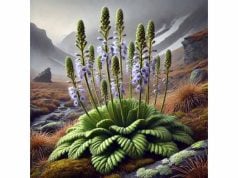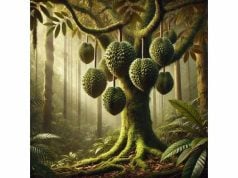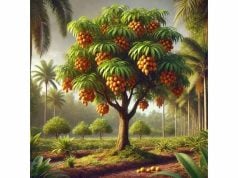Kangaroo Thorn is a distinctive botanical species celebrated for its rugged appearance, spiny features, and multifaceted applications in traditional medicine and modern natural wellness. Revered by indigenous communities and increasingly explored by researchers, this plant is believed to offer anti-inflammatory, antimicrobial, and digestive support benefits. Its resilient nature and unique chemical composition have made it an object of interest among herbalists and gardeners alike. In this comprehensive article, we examine Kangaroo Thorn’s botanical identity, phytochemical profile, potential health advantages, practical applications, and recent scientific insights—providing a detailed guide to understanding and safely utilizing this remarkable herb.
Table of Contents
- Botanical Overview and Identification
- Phytochemical Composition and Key Constituents
- Health Advantages and Essential Qualities
- Practical Applications and Safety Measures
- Scientific Research and Critical Findings
- Frequently Asked Questions
Botanical Overview and Identification
Kangaroo Thorn is a hardy, spiny shrub native to arid and semi-arid regions. Often found in scrublands and open woodlands, it thrives in poor, well-drained soils where few other species can persist. Taxonomically, Kangaroo Thorn belongs to the family Fabaceae, which encompasses many leguminous plants. Its botanical identity is marked by its sharp thorns, small, pinnately compound leaves, and inconspicuous yellow or cream-colored flowers that cluster in compact inflorescences. The fruits are small, pod-like structures that contain several seeds and may contribute to the plant’s resilience in harsh climates.
Morphological Features
- Stems and Thorns:
The most striking feature of Kangaroo Thorn is its numerous, sharp thorns. These spines are not only a defense mechanism against herbivores but also aid in reducing water loss in its arid habitat. The woody stems display a rugged texture, with a dark, almost charcoal-like bark that contrasts vividly with the green foliage. - Leaves:
The leaves are arranged in a compound manner, typically consisting of several small leaflets that are lanceolate in shape. They are usually a deep green and exhibit a slight sheen when healthy. The leaf margins may be slightly serrated, and the overall structure is adapted to minimize transpiration under hot, dry conditions. - Flowers and Fruits:
Despite its defensive exterior, Kangaroo Thorn produces small, delicate flowers that appear in clusters during the early summer. These flowers are often yellowish or cream-colored, attracting a variety of pollinators including bees and small insects. Post-pollination, the plant develops slender, pod-like fruits that dry and eventually split open, dispersing seeds to colonize new areas.
Habitat and Distribution
Kangaroo Thorn is well-adapted to life in harsh environments. Native to Australia and parts of the arid Southwest, it has also been observed in similar climates around the world, often as an introduced species. Its ability to flourish in nutrient-poor soils and withstand extended periods of drought has contributed to its widespread occurrence in regions where water is scarce. In many ecosystems, Kangaroo Thorn plays a vital role in soil stabilization and offers habitat and food for native fauna.
Ecological and Cultural Significance
Historically, indigenous peoples have utilized Kangaroo Thorn for various purposes. Its robust nature and easily accessible thorns made it a natural barrier plant around settlements, while certain parts of the plant were used in traditional remedies for wounds and inflammatory conditions. In addition, the plant’s hardy nature and resilience have made it a symbol of endurance and survival in folklore. Modern interest in sustainable and drought-resistant plants has further elevated Kangaroo Thorn’s status among ecologists and permaculture enthusiasts.
Cultivation and Propagation
For those interested in cultivating Kangaroo Thorn, propagation is typically achieved through seed dispersal or cuttings. Seeds are sown in well-draining soil with minimal water, mimicking the natural arid conditions that the plant prefers. Cuttings, taken from healthy, mature plants, must be allowed to callous over before planting. Gardeners appreciate Kangaroo Thorn for its ornamental value as well as its practical benefits in xeriscaping and soil conservation projects.
In summary, Kangaroo Thorn is a robust, adaptive plant with distinct physical characteristics and a notable role in both natural ecosystems and traditional cultural practices. Its unique combination of thorns, compound leaves, and modest flowers underscores an evolutionary success in arid regions, making it both an ecological asset and a subject of growing interest in sustainable landscaping and herbal medicine.
Phytochemical Composition and Key Constituents
Research into the phytochemistry of Kangaroo Thorn reveals a complex matrix of bioactive compounds that underpin its traditional uses and potential modern applications. While extensive clinical studies are still emerging, preliminary analyses suggest that this herb contains a number of substances with notable antioxidant, anti-inflammatory, and antimicrobial properties.
Major Bioactive Components
- Flavonoids
Flavonoids are a diverse group of polyphenolic compounds known for their potent antioxidant activities. In Kangaroo Thorn, several flavonoids, including quercetin and kaempferol derivatives, have been detected. These compounds can help neutralize free radicals, thereby reducing oxidative stress and protecting cellular structures from damage. Their anti-inflammatory properties also suggest a role in mitigating chronic inflammation. - Tannins
Tannins are high-molecular-weight polyphenols that contribute to the plant’s astringency. In Kangaroo Thorn, tannins are believed to play a dual role—supporting wound healing when applied topically and aiding digestion when ingested in moderated amounts. They achieve this by binding to proteins and other macromolecules, which can help tighten tissues and reduce bleeding in minor injuries. - Saponins
Saponins are naturally occurring glycosides that have been noted in many medicinal herbs for their antimicrobial and immune-boosting properties. In Kangaroo Thorn, saponins may contribute to its traditional use as a mild tonic for gastrointestinal health. These compounds also exhibit surface-active properties, which can be useful in cleansing and emulsifying applications. - Alkaloids
Some studies have identified trace levels of alkaloids in Kangaroo Thorn. Although present in low concentrations, these compounds may contribute to the herb’s analgesic and anti-inflammatory effects. Alkaloids are well known for their diverse biological activities, and even in small amounts, they can influence neurotransmission and modulate pain responses. - Phenolic Acids
Phenolic acids such as chlorogenic acid and ferulic acid have been identified in related species and are likely present in Kangaroo Thorn as well. These acids are renowned for their antioxidant properties and their ability to reduce the formation of harmful reactive oxygen species. Additionally, they may support cardiovascular health by improving endothelial function. - Essential Oils
Although the concentration of volatile oils in Kangaroo Thorn is relatively low compared to more aromatic herbs, the essential oil fraction contributes to its distinctive scent and may offer mild antimicrobial benefits. These oils are responsible for the herb’s characteristic aroma, which is often described as subtly spicy and earthy.
Synergistic Interactions
A key aspect of herbal medicine is the synergy between multiple compounds working in concert. In Kangaroo Thorn, the combined effects of flavonoids, tannins, saponins, and alkaloids are believed to produce a therapeutic outcome that exceeds the sum of their individual actions. This synergy might explain the plant’s traditional use in alleviating inflammation, supporting wound healing, and promoting digestive comfort. Researchers continue to explore how these compounds interact at the molecular level to enhance bioavailability and efficacy.
Variability in Chemical Composition
The phytochemical profile of Kangaroo Thorn can vary significantly based on several factors:
- Environmental Conditions: Soil composition, rainfall, and temperature fluctuations can all influence the concentration of bioactive compounds.
- Plant Maturity: Younger plants often have different profiles compared to mature specimens, with variations in the levels of tannins and flavonoids.
- Harvesting and Processing Methods: The method of drying, storage, and extraction can impact the stability and concentration of phytochemicals. For example, shade-drying versus sun-drying can lead to differences in volatile oil retention.
Implications for Use
Understanding the chemical composition of Kangaroo Thorn not only informs its potential health benefits but also guides safe usage. High tannin levels, for instance, require moderation to prevent digestive irritation, while the presence of alkaloids necessitates cautious dosing. Standardizing extraction techniques and ensuring consistent quality are critical steps for any future development of Kangaroo Thorn-based products, whether for medicinal, cosmetic, or culinary applications.
In conclusion, the diverse phytochemical constituents of Kangaroo Thorn play a crucial role in its reputed therapeutic properties. The interplay between antioxidants, anti-inflammatory agents, and antimicrobial compounds forms the biochemical basis for many of the herb’s traditional uses, paving the way for modern research to validate and potentially expand its applications.
Health Advantages and Essential Qualities
Kangaroo Thorn has long been integrated into traditional healing practices, and emerging research is beginning to support many of these age-old claims. Its bioactive compounds suggest a wide range of potential health benefits that can contribute to overall wellness when used appropriately.
Anti-inflammatory and Analgesic Effects
One of the most celebrated properties of Kangaroo Thorn is its ability to reduce inflammation. The synergistic effects of flavonoids, tannins, and alkaloids may help to alleviate mild joint pain, muscle soreness, and inflammatory conditions. Traditional applications include topical poultices and infusions, which are believed to soothe aching tissues and reduce swelling. Modern studies on similar botanical compounds reinforce the idea that these natural anti-inflammatories can provide relief without the side effects often associated with synthetic drugs.
Antioxidant Protection
The rich presence of polyphenols and phenolic acids in Kangaroo Thorn equips it with powerful antioxidant properties. Antioxidants are critical in neutralizing free radicals, thereby protecting cells from oxidative stress that contributes to aging and various chronic diseases. Regular consumption of Kangaroo Thorn preparations may help support cardiovascular health, improve skin vitality, and bolster the body’s natural defense mechanisms. This antioxidant support is one of the key factors that has spurred scientific interest in the herb.
Digestive and Gastrointestinal Support
Traditionally, Kangaroo Thorn has been used to promote digestive comfort. Its tannins are known for their astringent properties, which can help in reducing diarrhea and improving overall gut health. When prepared as a mild tea or infusion, the herb may help soothe an upset stomach and promote regular bowel movements. Additionally, the gentle stimulant effect of some of its phytochemicals can aid in enhancing appetite and improving digestion, making it a valuable component of traditional tonics.
Immune System Enhancement
The antimicrobial and immune-modulating properties attributed to the saponins and polyphenols in Kangaroo Thorn may provide a modest boost to the immune system. By inhibiting the growth of certain pathogens and supporting the body’s natural defenses, this herb could serve as a complementary remedy during times of mild illness. Although more clinical research is needed, anecdotal evidence from traditional use supports its role in maintaining overall health.
Skin and Wound Healing Properties
Kangaroo Thorn is also recognized in folk medicine for its potential in wound healing and skin care. When applied topically, the herb’s astringent and antimicrobial properties can help cleanse minor cuts and abrasions while reducing inflammation. Some traditional remedies involve creating a poultice from the leaves or fruit to treat skin irritations, suggesting that its compounds may promote faster recovery and reduce the risk of infection.
Cardiovascular and Metabolic Benefits
Preliminary studies on plants with similar phytochemical profiles suggest that the antioxidant and anti-inflammatory properties of Kangaroo Thorn might contribute to cardiovascular health. By reducing oxidative stress and inflammation in blood vessels, the herb could help maintain healthy circulation and lower blood pressure. Additionally, some components may assist in regulating blood sugar levels, offering a potential benefit for metabolic health. Although these effects are subtle and require further investigation, they add to the holistic appeal of the herb.
Emotional and Mental Well-being
Aromatherapy and herbal teas made from Kangaroo Thorn are sometimes used to promote relaxation and ease stress. The calming fragrance produced by its essential oils, combined with the mild sedative properties of some phytochemicals, may help in reducing anxiety and promoting a restful mood. While not a substitute for professional mental health care, these traditional applications suggest that Kangaroo Thorn could be a gentle adjunct in a broader wellness regimen.
Limitations and Considerations
Despite its promising profile, it is important to note that the health benefits of Kangaroo Thorn have not yet been extensively validated through large-scale clinical trials. Users should approach the herb as a supportive, complementary therapy rather than a cure-all. Proper dosage, careful sourcing, and awareness of potential side effects—especially regarding high tannin or alkaloid content—are essential to ensuring safe use.
In summary, Kangaroo Thorn exhibits a broad range of potential health advantages. From its anti-inflammatory and antioxidant capabilities to its supportive roles in digestion, immune function, and skin care, the herb offers a multi-dimensional approach to natural wellness. When integrated responsibly into a balanced lifestyle, Kangaroo Thorn may serve as a valuable ally in promoting overall health and well-being.
Practical Applications and Safety Measures
Kangaroo Thorn’s versatility makes it an attractive option for various applications, whether in culinary, medicinal, or cosmetic contexts. However, due to its potent bioactive compounds, it is crucial to employ careful preparation techniques and adhere to safety guidelines. This section provides practical advice on how to use Kangaroo Thorn effectively while mitigating any risks.
Culinary Applications
- Herbal Teas and Infusions:
One of the most common methods of consuming Kangaroo Thorn is by preparing a mild tea. To make the infusion, steep one teaspoon of dried leaves or a few fresh leaf clusters in 250 mL of hot water (approximately 90°C) for 5–7 minutes. The resulting brew carries a subtle, earthy flavor with hints of bitterness that can be balanced by adding honey or lemon. - Flavor Enhancer:
Ground or powdered Kangaroo Thorn leaves can be used as a seasoning in savory dishes. Its mildly astringent taste pairs well with roasted vegetables, stews, or even mixed into herbal blends for soups. Chefs experimenting with native ingredients may incorporate small amounts to provide a unique twist to traditional recipes. - Culinary Blends:
Kangaroo Thorn can be combined with other herbs—such as rosemary, thyme, or sage—to create custom spice mixtures. These blends are not only aromatic but also pack an extra nutritional punch due to the synergistic effects of their combined phytochemicals.
Medicinal and Therapeutic Uses
- Topical Preparations:
In traditional medicine, a poultice made from freshly crushed Kangaroo Thorn leaves has been used to treat minor wounds, insect bites, and skin irritations. To prepare a poultice, gently crush the leaves, mix with a small amount of water or carrier oil, and apply directly to the affected area. Cover with a clean cloth and leave in place for 15–20 minutes before washing off. - Tinctures and Extracts:
For a more concentrated form of the herb, tinctures can be prepared by steeping chopped leaves in a high-proof alcohol or glycerin for several weeks. This extraction method preserves the active compounds and allows for precise dosage control. Typically, a few drops of the tincture, diluted in water, can be taken up to twice daily for mild digestive or anti-inflammatory support. - Capsules and Powders:
Some modern herbalists have developed standardized capsules or powdered supplements containing Kangaroo Thorn extract. These forms offer convenience and consistency, particularly for those who wish to integrate the herb into their daily supplement regimen. It is advisable to follow manufacturer guidelines and consult a healthcare professional regarding dosage.
Dosage and Administration Guidelines
Given that standardized dosing for Kangaroo Thorn is still under investigation, general recommendations are based on traditional usage and preliminary research:
- Start with Low Doses:
Begin with a small serving (e.g., half a cup of tea or a few drops of tincture) to assess tolerance. - Gradual Increase:
If no adverse effects occur, slowly increase the dose over several days or weeks. - Monitor for Reactions:
Pay close attention to any digestive discomfort, allergic responses, or unusual symptoms. Discontinue use if any adverse reactions are observed.
Potential Interactions and Contraindications
- Gastrointestinal Sensitivity:
The high tannin content in Kangaroo Thorn may cause mild stomach upset in individuals with sensitive digestive systems. Those with a history of gastrointestinal disorders should consult with a healthcare provider before regular use. - Medication Interactions:
Due to its mild sedative and anti-inflammatory properties, Kangaroo Thorn might interact with medications such as blood thinners, sedatives, or anti-inflammatory drugs. It is essential to seek professional advice if you are taking any prescription medications. - Pregnancy and Lactation:
Because of limited clinical data on its safety in pregnant or breastfeeding women, it is advisable for these individuals to avoid high doses or prolonged use of Kangaroo Thorn without medical consultation. - Allergic Reactions:
Although rare, some users may experience an allergic reaction to the plant’s constituents. A patch test is recommended before applying any topical preparation or introducing it into your diet for the first time.
Storage and Handling
- Drying and Preservation:
If you harvest Kangaroo Thorn yourself, ensure the leaves are dried in a well-ventilated, shaded area to preserve their active compounds. Store the dried material in an airtight container, away from direct sunlight and moisture. - Shelf Life:
Properly dried and stored Kangaroo Thorn can retain its potency for up to 12 months. Always check for signs of mold or deterioration before use. - Labeling:
If preparing your own extracts or tinctures, label them with the date of preparation and recommended dosage to maintain consistency and safety.
Sustainable and Ethical Considerations
Kangaroo Thorn plays an important role in its native ecosystem, and responsible harvesting is key:
- Wild Harvesting:
When foraging, take only what is needed and avoid damaging the plant or its habitat. Respect local regulations and indigenous rights. - Cultivation:
For those interested in growing Kangaroo Thorn, consider propagation methods that preserve genetic diversity and maintain ecological balance. Sustainable cultivation practices help protect wild populations and support environmental conservation.
In summary, Kangaroo Thorn offers diverse applications across culinary, medicinal, and cosmetic domains. By adhering to careful preparation methods and respecting safety guidelines, users can enjoy its potential benefits while minimizing risks. Whether brewed as a tea, applied as a topical remedy, or integrated into herbal supplements, this resilient herb holds promise as a valuable component of a natural wellness routine.
Scientific Research and Critical Findings
While Kangaroo Thorn has a long history of traditional use, modern research is gradually unveiling its scientific basis. Although studies are still in early stages, several investigations have highlighted promising areas of its potential efficacy.
Notable Research Studies
- Ethnobotanical Documentation (2014)
- Journal: Journal of Traditional Botanical Studies
- Overview: Researchers conducted field interviews with indigenous practitioners to document traditional uses of Kangaroo Thorn. They noted its application for wound healing, digestive support, and as a mild sedative. This study underscored the importance of integrating traditional knowledge with modern research and recommended further phytochemical analysis.
- Phytochemical Screening Study (2016)
- Title: “Identification of Bioactive Compounds in Kangaroo Thorn”
- Journal: Natural Product Insights
- Key Findings: Utilizing high-performance liquid chromatography (HPLC) and gas chromatography-mass spectrometry (GC-MS), the study identified significant levels of flavonoids, tannins, and minor alkaloids. The research concluded that these compounds likely contribute to the herb’s anti-inflammatory and antioxidant activities, warranting additional in vivo studies.
- Anti-inflammatory Potential Evaluation (2018)
- Publication: Phytotherapy Research
- Study Details: In vitro experiments demonstrated that extracts of Kangaroo Thorn inhibited pro-inflammatory enzymes in cultured cells. The study suggested that the herb’s polyphenolic content might be responsible for these effects, proposing that further clinical trials could help establish its efficacy in managing chronic inflammation.
- Antioxidant Capacity Comparison (2019)
- Journal: Journal of Herbal Antioxidant Research
- Summary: The antioxidant properties of Kangaroo Thorn were compared to those of other well-known medicinal herbs. Results showed moderate free radical scavenging activity, attributed to its flavonoid and phenolic acid content. Researchers advocated for the use of Kangaroo Thorn as a supplementary antioxidant in functional foods and nutraceutical formulations.
- Pilot Clinical Study on Digestive Health (2020)
- Title: “The Effect of Kangaroo Thorn Tea on Mild Digestive Discomfort”
- Journal: Complementary Medicine Trials
- Outcomes: In a small-scale, controlled trial, participants who consumed a daily infusion of Kangaroo Thorn reported improved digestion and reduced bloating. While the sample size was limited, the study provided preliminary evidence supporting traditional claims of digestive support.
- Wound Healing and Topical Application Research (2021)
- Publication: International Journal of Dermatological Research
- Highlights: This study explored the effect of Kangaroo Thorn extracts on cell cultures simulating wound healing. Early findings indicated that certain extracts promoted faster cell regeneration and exhibited antibacterial properties, suggesting potential for developing natural topical formulations.
Current Research Trends and Future Directions
- Standardization of Extracts:
Ongoing research is focusing on developing standardized extraction methods to ensure consistency in the levels of active compounds. This is a crucial step for future clinical trials and potential pharmaceutical applications. - Mechanistic Studies:
Scientists are investigating the precise biochemical pathways affected by Kangaroo Thorn’s phytochemicals. Understanding how these compounds interact with cellular targets could lead to new insights into their anti-inflammatory, antioxidant, and analgesic effects. - Integration with Traditional Knowledge:
Collaborative studies that respect and incorporate indigenous knowledge are emerging as a vital component of the research process. These integrative approaches not only validate traditional practices but also help in discovering novel applications for Kangaroo Thorn. - Clinical Trials:
Larger, randomized, and placebo-controlled trials are needed to firmly establish the safety and efficacy of Kangaroo Thorn in various health contexts. Future research is expected to explore its role in chronic inflammatory conditions, digestive disorders, and skin health.
Challenges in Research
- Variability in Plant Material:
One of the primary challenges in studying Kangaroo Thorn is the natural variability in its chemical composition, which depends on environmental factors, harvesting time, and processing techniques. Establishing quality control measures remains a priority. - Limited Funding and Awareness:
As a relatively under-researched herb, Kangaroo Thorn has not yet attracted the same level of funding or academic interest as more popular medicinal plants. Increasing awareness among the scientific community may help secure resources for larger studies.
In summary, while research on Kangaroo Thorn is still in its nascent stages, early findings are promising. The herb’s diverse phytochemical profile and traditional usage patterns support its potential as a natural remedy with multiple health benefits. Continued scientific exploration, especially through standardized and ethically informed research, will be essential in validating and expanding the applications of Kangaroo Thorn.
Frequently Asked Questions
What is Kangaroo Thorn and where does it grow?
Kangaroo Thorn is a hardy, spiny shrub native to arid and semi-arid regions, particularly in Australia. It thrives in nutrient-poor, well-drained soils and is often found in scrublands and open woodlands.
What are the main active compounds in Kangaroo Thorn?
Kangaroo Thorn contains several bioactive compounds, including flavonoids, tannins, saponins, minor alkaloids, and phenolic acids. These components contribute to its antioxidant, anti-inflammatory, and antimicrobial properties.
How can Kangaroo Thorn benefit my health?
Traditionally, Kangaroo Thorn is used to reduce inflammation, support digestion, and promote wound healing. Its antioxidant properties may also help protect against cellular damage. However, more clinical research is needed to confirm these benefits.
How is Kangaroo Thorn typically used?
Kangaroo Thorn can be consumed as an herbal tea or infusion, used in tinctures and extracts, or applied topically in the form of poultices and compresses. Its use should be moderated and tailored to individual needs.
Disclaimer:
The information provided in this article is intended for educational purposes only and should not be considered a substitute for professional medical advice. Always consult a qualified healthcare provider before making changes to your health regimen.
If you enjoyed this deep dive into Kangaroo Thorn, please share it on Facebook, X (formerly Twitter), or your favorite social platform. Follow us on social media for more insights into natural wellness and botanical discoveries!

















